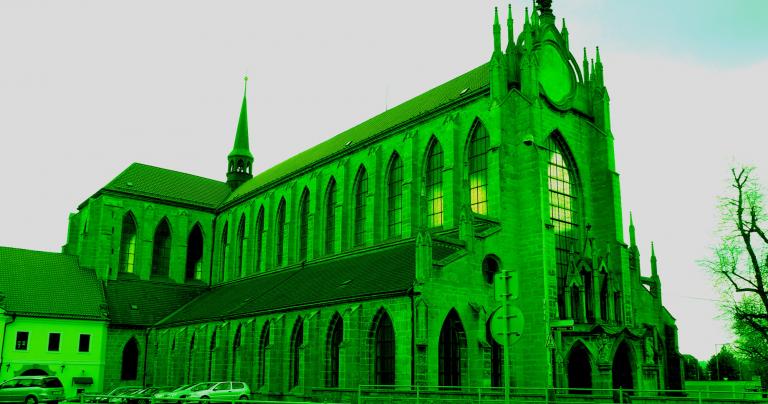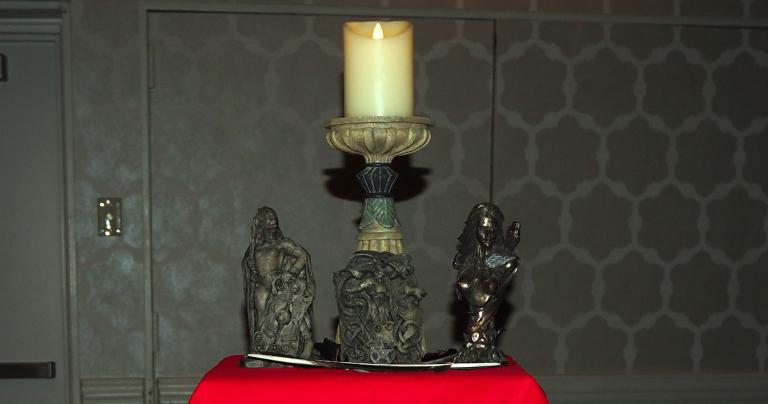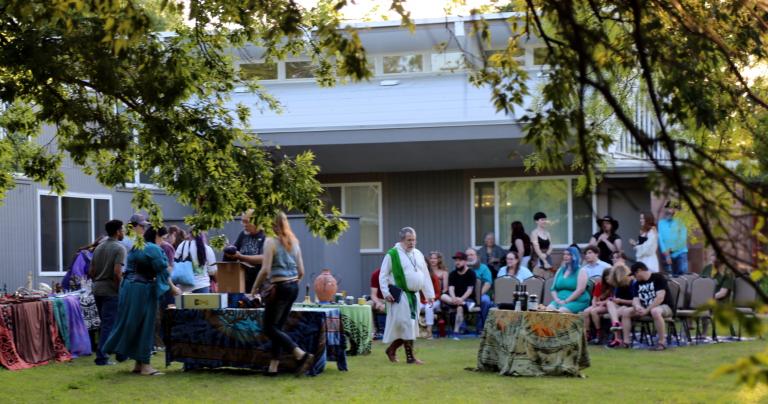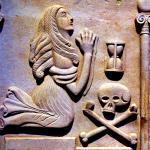Recently I’ve seen two deep and heart-felt comments from Pagans that I’ll describe as “Catholic envy.” Both are committed polytheists, but both are also envious of the Catholic church with their physical churches in every town (and in some cities, in every neighborhood), professional clergy, established seminaries and monasteries, and all the stability and continuity that comes from being the largest religious institution in the world (depending on if you consider the Sunni version of Islam to be one thing, which I don’t).
I understand their envy, and I share it to a certain extent.
Let’s be clear what we’re envious about. Despite the occasional off-hand comment from the current pope that hints at inclusivity, Catholic theology is exclusivist and therefore not something I support. I support their politics on justice for the poor and against the death penalty, and I just as strongly oppose their politics on reproductive rights and the equality of women. Their history of abuse – whether we’re talking about the Inquisition, the Magdalene Laundries, or the rape of children by priests – is long and has not been accounted for, which means we cannot be sure it has ended.
And none of that is the point here. Neither my friends nor I have any great love for the Catholic church. But we cannot help but be envious of its institutions, and we wish we had similar resources in our Pagan and polytheist religions.
A large percentage of Pagans are solitary practitioners. The institutions we do have – such as OBOD, ADF, Covenant of the Goddess, and CUUPS – are fine organizations, but at best they’re networks of small local groups and solitaries. They’re not even close to being the same thing, and won’t be in our lifetime, if ever.
There’s a reason envy is one of the seven deadly sins (which are a Catholic invention). It focuses our attention on what we lack instead of on what we have, and if we are not careful, can cause us to resent our neighbors’ abundance while ignoring our own. It can cause it to chase things we do not need and sometimes do not even want.
The best way to combat envy is to approach it head-on, examine our desires, and then figure out if we should work toward obtaining these things for ourselves or simply focus on our own lives as they are.
So I’d like to take a look at Catholic envy in the contemporary Pagan movement.
Paganism is a movement, not an institution
The Catholic church is an institution. Paganism and polytheism are movements. The primary difference is that institutions have boundaries – either you’re in or you’re out. Movements have no boundaries – they have a center and a direction. Beginning in 2013, we identified four centers of the modern Pagan movement: Nature, the Gods, the Self, and Community.
Because of their tighter boundaries and focus, institutions are far more capable of marshalling resources to build and maintain “sub-institutions” like temples and schools. Even when we have adequate numbers we rarely have the narrowly defined commitments necessary to support infrastructure.
This is the nature of a loosely defined movement. If Paganism was one thing, things would be different. But it’s not one thing, and it’s never going to be one thing. There will be no Pagan Council of Nicaea. We will remain a movement, and it’s hard for movements to build institutions.
But it’s not impossible.
Religious institutions must be built on spiritual depth
We can all come together for something like Pagan Pride Day centered on nothing more than a vague identity as Pagans. But Pagan Pride Day is a once-a-year gathering that doesn’t require most people to do anything more than show up for a few hours (though organizers invest substantially more time and effort that usually goes thankless).
Want to build a temple? Great – what deities will be enshrined there? Denton CUUPS Pantheon ritual was a great success, but does anybody really want to try to build a permanent temple to house 35 deities from at least seven different traditions? And once you start enshrining individual deities, will the “Goddess and God” Pagans and the non-theistic Pagans want to participate? Will the Hellenists be willing to share space with the Heathens, much less share rituals?
Getting to the level of commitment that will allow us to build substantial infrastructure won’t happen by different flavors of Pagans “putting aside their differences” (better stated as “important cultural and theological diversity”). It will come when one or two or six traditions develop enough spiritual depth to appeal to a larger number of people and develop the necessary resources on their own.
The leadership dilemma
You cannot build an institution without strong, competent leaders. At the same time, a group has to move from dependence on key individuals to operating as an institution. Isaac Bonewits founded ADF, but he stepped down as Archdruid in 1996 and died in 2010. ADF is still going strong. It transcended Isaac – it became an institution.
At the same time, no organization – whether institution or movement or something else – can last for long without good leadership. One of the reasons so many Pagan groups fail is that when their founder(s) die or burn out or just move on, there is no one to replace them.
We need a bigger pool of leaders. We need more people who are capable and willing to make sure the group fulfills its mission and does what it says it’s going to do, no matter what. Many people are capable of doing this – far fewer are willing.
Most Pagan groups have enough trouble attracting ordinary members – trying to recruit leaders from the general public is virtually impossible. But if we attract more people in general, that give us more chances to find someone with leadership capabilities.
Of course, it helps if we don’t burn our leaders at the stake…
Prioritize the movement
I want to be part of something bigger and longer-lasting than myself. Though I believe we live on after death, I am certain we live on in the families and communities of which we are a part. Right now, our immortality as Pagans is in the movement, not in institutions.
I expect OBOD will continue long after I move on to the Otherworld. ADF is much smaller and CUUPS is smaller still – while I expect them to continue, I’m less confident they’ll be around in two hundred years. But I’m sure Paganism and polytheism will persist. Their roots are older and far broader; they speak to basic human desires for connection to Nature and to the Gods.
Our legacy is in the movement. And the stronger the movement, the larger the pool of Pagans to fill our individual paths and traditions.
But build strong local groups
The word “religion” comes from the Latin religare meaning “to bind together.” Religion is about relationships with other persons, and while some of those persons are Gods and spirits, others are living humans.
There is no substitute for gathering together to celebrate Beltane, to work magic for a sick friend, or to discuss the nature of the Gods around a bottle of wine. I love my Facebook friends and they are my friends, but there’s no substitute for someone who can come to your house when you really need to see and hear and touch someone.
There are a million reasons why people choose to be solitary and most of them are valid. That doesn’t negate the need for strong local groups. You must do what you think is best for you, but the stronger and deeper your local connections, the better.
Stop fixating on Christianity, either Catholic or Protestant.
If we had stronger Pagan groups, Pagan institutions, and a Pagan movement we would have far fewer reasons to be envious of the Catholics and what they have. But I need to address “Catholic envy” directly.
Stop it.
Stop the envy for Protestant institutions and infrastructure too.
It’s not that envy is a mortal sin – as a Pagan I don’t believe in mortal sins and I’m not sure I believe in sin at all.
The modern Pagan movement is at best 150 years old. Realistically it’s better to date it from the publication of Witchcraft Today in 1954, making it 65. How can you compare that to a religion that’s 2000 years old and was the overwhelmingly predominant religion in the West for 1500? As much as I’d like to have temples in every city and some of them as big and ornate as cathedrals and all the things that go with all that, that’s not going to happen in the lifetime of anyone alive today.
Catholic envy is a useless distraction from the Paganism we can build here and now.
We can learn more from Judaism and Buddhism
If you want to look at other religions for ideas, there are more relevant choices than Catholicism.
Judaism has been a minority religion for over two millennia, and a persecuted minority for most of that time. Yet it has persisted, and is considered one of the “Big Five” world religions. There is much we can learn about forming and maintaining a religious identity from our Jewish friends.
Buddhism is far less hierarchical than Christianity and just as diverse. Also, the relationship between monks and lay Buddhists is rather different from that between Christian clergy and laity, in a way that may be instructional for Pagans.
I’m no expert on Judaism or Buddhism, but I know enough about them to realize they’re both significantly different from Christianity, in more ways than beliefs. It isn’t helpful to be envious of Jewish synagogues or Buddhist monasteries, but if we’re going to study the institutions of other religions, let’s look farther than what we see on the nearest street corner.
We know something about how our Pagan ancestors organized their religions – a lot about Egypt and Greece, less about Scandinavia and the Celtic lands. But those were either state religions, or the near-universal indigenous religions of the people. We can learn from them and be inspired by them, but trying to copy them is no more likely to be helpful than trying to copy the Catholics.
Envy is not helpful
Call it a sin, call it a vice, call it human nature. Whatever you call it, envy isn’t helpful.
It’s one thing to admire the beauty of an exceptionally attractive person. It’s another thing to become so obsessed with the artificial beauty of celebrities that we lose sight of the ordinary but real beauty of our spouses and partners.
I’m pretty sure both of my friends who inspired this post are on the healthy side of their attraction to the Catholic church. And I’m just as sure that many Pagans aren’t.
We’re Pagans because something called to us. Whatever that something (or Someone) was, it wasn’t institutions and infrastructure. Let’s answer those calls and become the best Pagans we can be, of whatever variety we choose or that chooses us.
And then we can build the institutions and infrastructure we need, here and now, and not mindlessly copy what they have in the religion we left.



















